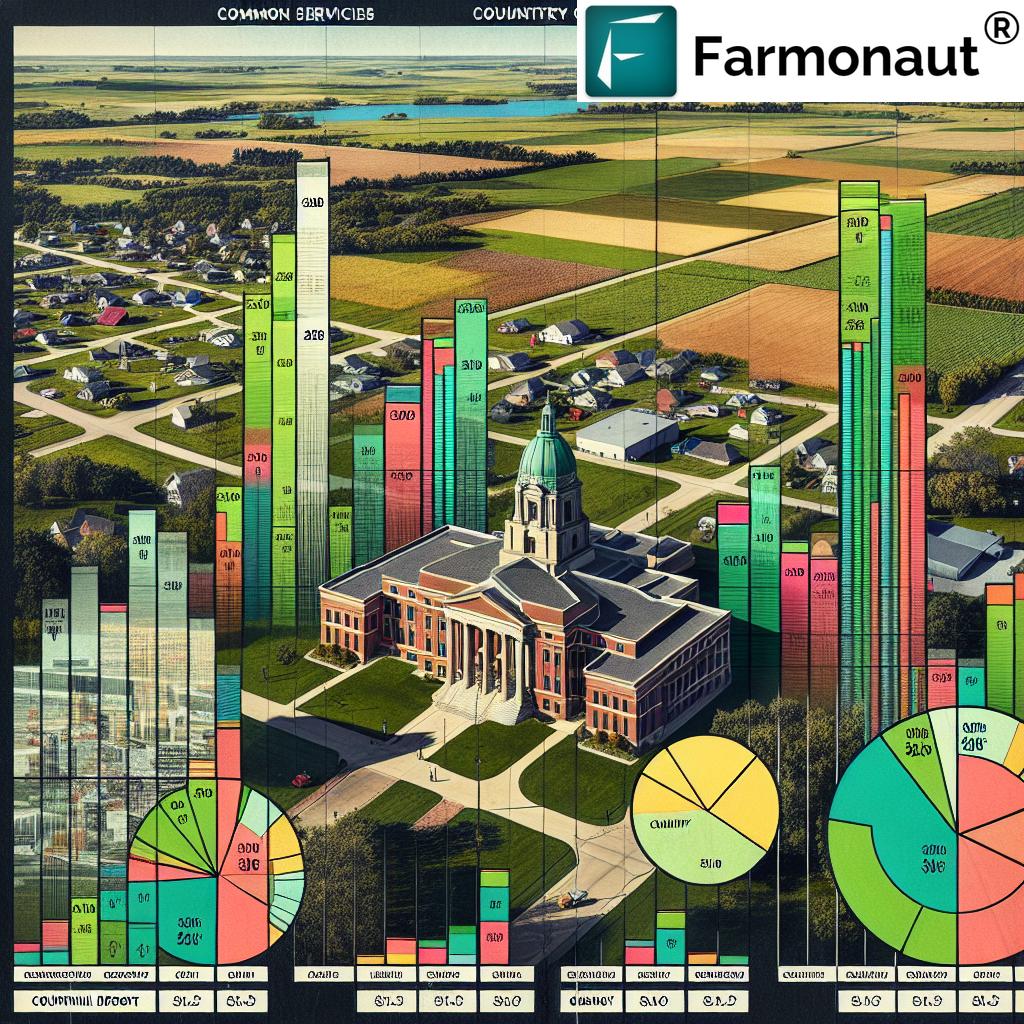Muscatine County’s Fiscal Transparency: Unveiling the Semi-Annual Financial Report and Budget Allocations
“Muscatine County utilizes GIS technology and TIF districts to enhance financial planning for over 20 different budget allocations.”
In the realm of local government finance, transparency and strategic planning are paramount. Today, we delve into the intricacies of Muscatine County’s fiscal management, showcasing how this Eastern Iowa county balances its diverse financial responsibilities while maintaining a commitment to fiscal transparency. Our comprehensive analysis of the semi-annual financial report for July to December 2024 offers valuable insights into the county’s economic landscape, budget allocations, and financial health.

Understanding Muscatine County’s Financial Structure
Muscatine County’s financial report is a testament to the complex nature of municipal budget management. The county’s fiscal structure is built upon a foundation of various funds, each serving specific purposes within the local government framework. Let’s break down the key components:
- General Basic Fund: This is the primary operating fund for the county, covering a wide range of day-to-day expenses and services.
- General Supplemental Fund: Provides additional support to the general basic fund for specific purposes.
- Rural Services Basic Fund: Dedicated to services provided in rural areas of the county.
- Secondary Road Fund: Allocated for the maintenance and improvement of county roads and bridges.
- Emergency Services Fund: Supports the county’s emergency response and management capabilities.
These funds, among others, form the backbone of Muscatine County’s financial operations, ensuring that essential services are maintained and the community’s needs are met.
Revenue Sources and Property Tax Allocation
One of the most critical aspects of local government finance is understanding the sources of revenue that fuel county operations. In Muscatine County, as with many local governments, property taxes play a significant role. The semi-annual report sheds light on how these taxes are collected and allocated across various funds and services.
Property tax allocation in Muscatine County is a carefully balanced process that takes into account the needs of different departments and services. The county’s use of GIS technology has revolutionized this process, allowing for more accurate assessments and efficient collection methods. This technological integration is a prime example of how modern tools can enhance traditional fiscal management practices.
In addition to property taxes, Muscatine County benefits from various other revenue streams, including:
- Sales taxes
- Intergovernmental transfers
- Fees and charges for services
- Grants and contributions
The diversity of these revenue sources helps to create a more stable financial foundation for the county, reducing reliance on any single income stream.
Debt Management and Fiscal Responsibility
Effective debt management is crucial for maintaining the long-term fiscal health of any municipality. Muscatine County’s financial report provides insights into how the county manages its debt obligations while continuing to invest in necessary infrastructure and services.
The county’s approach to debt management involves:
- Careful monitoring of debt levels
- Strategic use of bonds for capital projects
- Maintaining healthy fund balances to ensure financial stability
By maintaining a balanced approach to debt, Muscatine County demonstrates its commitment to fiscal responsibility and long-term financial planning.
TIF Districts and Economic Development
Tax Increment Financing (TIF) districts are powerful tools for local economic development, and Muscatine County has effectively leveraged this strategy. TIF districts allow the county to reinvest property tax revenue increases from a designated area back into that same area, spurring development and growth.
The use of TIF districts in Muscatine County has:
- Attracted new businesses to the area
- Funded infrastructure improvements
- Contributed to job creation and economic expansion
This strategic use of TIF districts aligns with the county’s broader economic development goals and helps to ensure a prosperous future for residents.

Budget Allocations Across Departments
The semi-annual financial report provides a detailed breakdown of how funds are distributed across various county departments and services. This transparency allows residents to understand how their tax dollars are being utilized and ensures accountability in government spending.
| Department/Service | Current Fiscal Year Budget (%) | Previous Fiscal Year Budget (%) | Percentage Change |
|---|---|---|---|
| General Fund | 35% | 33% | +2% |
| Rural Services | 15% | 16% | -1% |
| Emergency Services | 10% | 9% | +1% |
| Secondary Roads | 25% | 26% | -1% |
| Historic Preservation | 2% | 2% | 0% |
| Other Services | 13% | 14% | -1% |
Key observations from the budget allocations include:
- A slight increase in the General Fund allocation, reflecting growing operational needs
- Consistent funding for Historic Preservation, underscoring the county’s commitment to cultural heritage
- A modest increase in Emergency Services funding, potentially in response to community safety needs
“Eastern Iowa counties manage complex budgets, balancing at least 5 major fund categories including general, rural services, and emergency services.”
Special Funds and Trust Management
Muscatine County’s financial report also details the management of various special funds and trusts. These include:
- Conservation Trust Fund: Dedicated to preserving natural resources and maintaining parks
- Seized Asset Fund: Manages assets obtained through law enforcement activities
- REAP Fund: Supports Resource Enhancement and Protection initiatives
The careful management of these funds demonstrates the county’s commitment to specialized areas of governance and community well-being.
Capital Projects and Infrastructure Investment
Investing in infrastructure is crucial for the long-term development and prosperity of any county. Muscatine County’s financial report highlights several ongoing and planned capital projects, including:
- Road and bridge improvements
- Public building renovations
- Technology upgrades for county services
These investments not only enhance the quality of life for residents but also contribute to the county’s economic competitiveness.
Emergency Services and Public Safety
A significant portion of Muscatine County’s budget is allocated to emergency services and public safety. This includes funding for:
- Law enforcement
- Fire protection
- Emergency medical services
- Disaster preparedness
The county’s commitment to these essential services is evident in the financial report, with dedicated funds ensuring that first responders have the resources they need to protect the community.
Rural Services and Agricultural Support
As a county with a significant rural population, Muscatine places a strong emphasis on supporting agricultural communities and rural development. The Rural Services Basic Fund plays a crucial role in this regard, providing funding for:
- Agricultural extension education
- Rural road maintenance
- Conservation efforts
- Rural development initiatives
This focus on rural services helps to maintain a balance between urban and rural needs within the county.
Technology Integration in Financial Management
Muscatine County’s use of GIS technology in financial planning and management is a testament to its commitment to modernization. This technology allows for:
- More accurate property assessments
- Efficient tracking of infrastructure projects
- Enhanced spatial analysis for budget allocation decisions
The integration of GIS into financial processes exemplifies how technology can improve transparency and efficiency in local government operations.
Intergovernmental Cooperation and Shared Services
The financial report also sheds light on Muscatine County’s collaborative efforts with neighboring jurisdictions. This includes:
- Shared emergency services with Louisa County
- Joint infrastructure projects with local municipalities
- Cooperative agreements for specialized services
These partnerships help to maximize resource utilization and improve service delivery across the region.
Transparency and Accountability Measures
Muscatine County’s commitment to fiscal transparency is evident throughout the semi-annual financial report. Key transparency measures include:
- Detailed breakdowns of revenues and expenditures
- Clear explanations of fund balances and transfers
- Regular public reporting of financial information
These practices ensure that residents have access to the information they need to understand and engage with county financial decisions.
Future Financial Planning and Challenges
Looking ahead, Muscatine County faces several financial challenges and opportunities, including:
- Balancing the need for infrastructure investment with fiscal constraints
- Adapting to changing demographics and service demands
- Preparing for potential economic fluctuations
The county’s proactive approach to financial planning, as evidenced in the semi-annual report, positions it well to address these challenges head-on.
Conclusion
Muscatine County’s semi-annual financial report offers a comprehensive look into the fiscal management practices of this Eastern Iowa county. From property tax allocation to debt management, from rural services to emergency funding, the report demonstrates a commitment to transparency, fiscal responsibility, and strategic planning.
As we’ve explored in this analysis, the county’s use of modern tools like GIS technology and TIF districts, combined with sound financial practices, creates a solid foundation for economic growth and community development. The careful balance of various funds and the clear allocation of resources across departments ensure that Muscatine County can meet the diverse needs of its residents while maintaining fiscal health.
This level of transparency in local government finance not only fosters trust among residents but also serves as a model for other municipalities seeking to improve their fiscal management practices. As Muscatine County continues to navigate the complex landscape of local government finance, its commitment to openness and strategic planning will undoubtedly serve it well in the years to come.
FAQ Section
Q: How often does Muscatine County release financial reports?
A: Muscatine County releases semi-annual financial reports, covering six-month periods of fiscal activity.
Q: What is a TIF district and how does it benefit the county?
A: A Tax Increment Financing (TIF) district is an economic development tool that allows the county to reinvest property tax revenue increases from a designated area back into that same area, spurring development and growth.
Q: How does Muscatine County ensure fiscal transparency?
A: The county ensures fiscal transparency through detailed financial reports, clear breakdowns of revenues and expenditures, and regular public reporting of financial information.
Q: What role does GIS technology play in the county’s financial management?
A: GIS technology is used for more accurate property assessments, efficient tracking of infrastructure projects, and enhanced spatial analysis for budget allocation decisions.
Q: How does Muscatine County balance rural and urban needs in its budget?
A: The county maintains a Rural Services Basic Fund dedicated to supporting agricultural communities and rural development, while also allocating resources to urban services and infrastructure.
For more information on Farmonaut’s agricultural technology solutions, visit our API page or check out our API Developer Docs.






